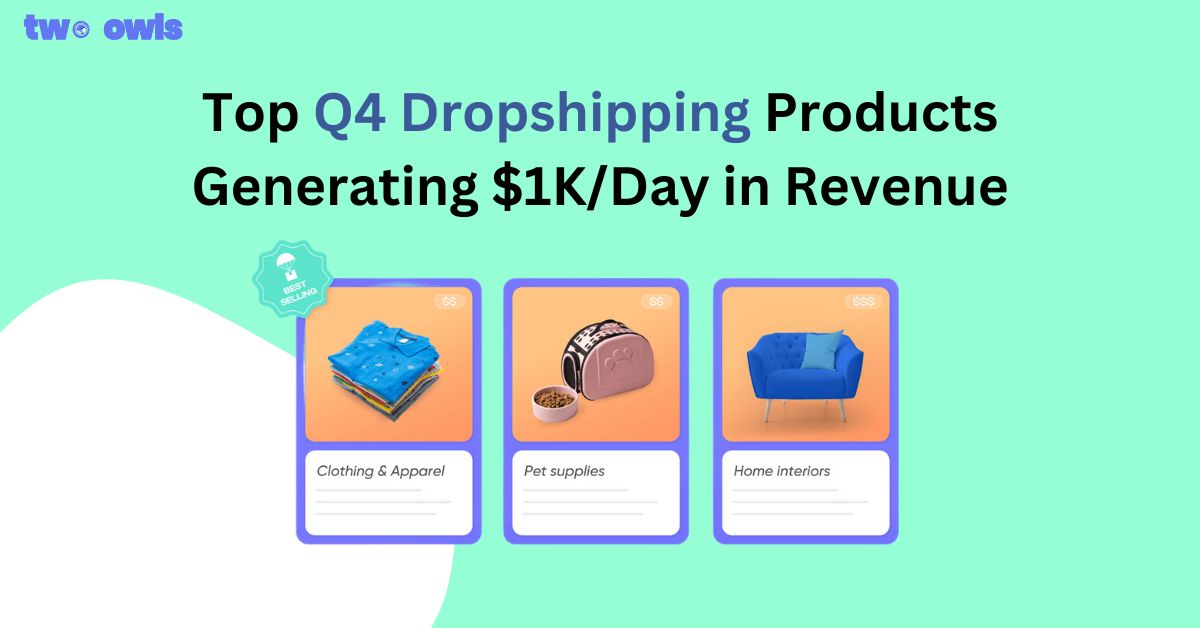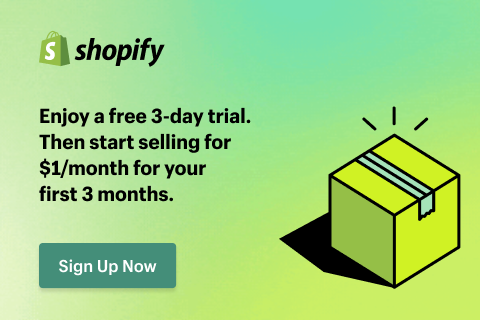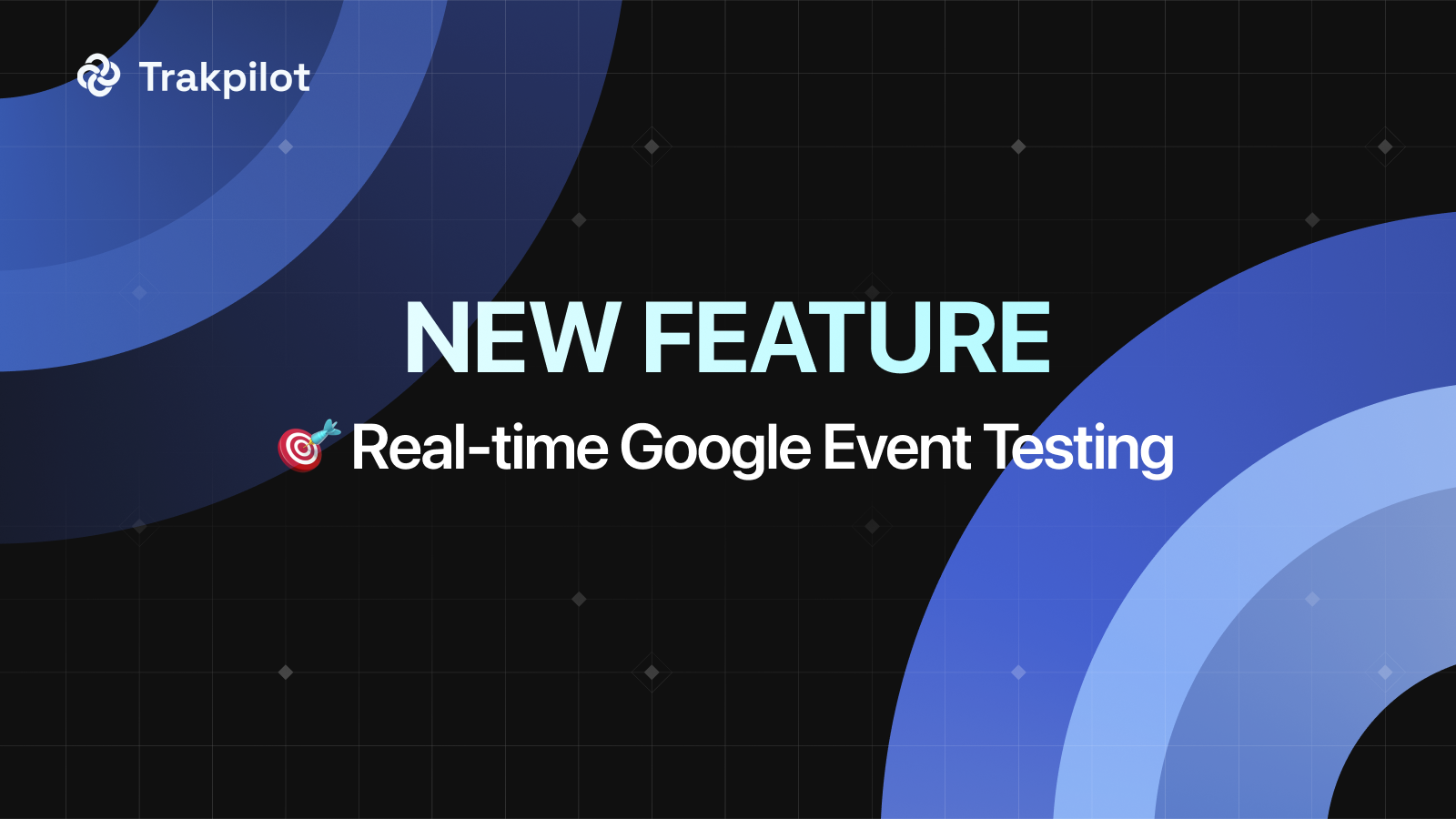What Is The Best Facebook Campaign Objectives in 2026?
Unlocking the potential of your online store involves mastering Facebook Ad objectives - your secret weapons for success! These strategic goals, like Awareness, Traffic, and Sales, aren't just buzzwords; they're your keys to conquering the e-commerce realm.
For small merchants, understanding these Facebook Campaign objectives is like having a supercharged map - it guides you through the digital landscape, helping you grow, engage, and sell like a pro. Time to turn those clicks into ka-chings!
What are Facebook Ad objectives (Facebook campaign objectives)?
Facebook campaign objectives are the goals you want to achieve with your Facebook ads. When you create a new ad campaign, you'll be asked to choose an objective. This tells Facebook what type of ad to show and how to optimize your campaign.
There are six Meta campaign objectives:
- Awareness: Increase brand awareness among people who are most likely to care about your business.
- Traffic: Drive traffic to your website, landing page, or app.
- Engagement: Get people to interact with your content, such as your posts, videos, or events.
- Leads: Generate leads for your business by getting people to sign up for your newsletter, download a white paper, or request a consultation.
- App Promotion: Promote your app and get more people to install it.
- Sales: Drive sales of your products or services.
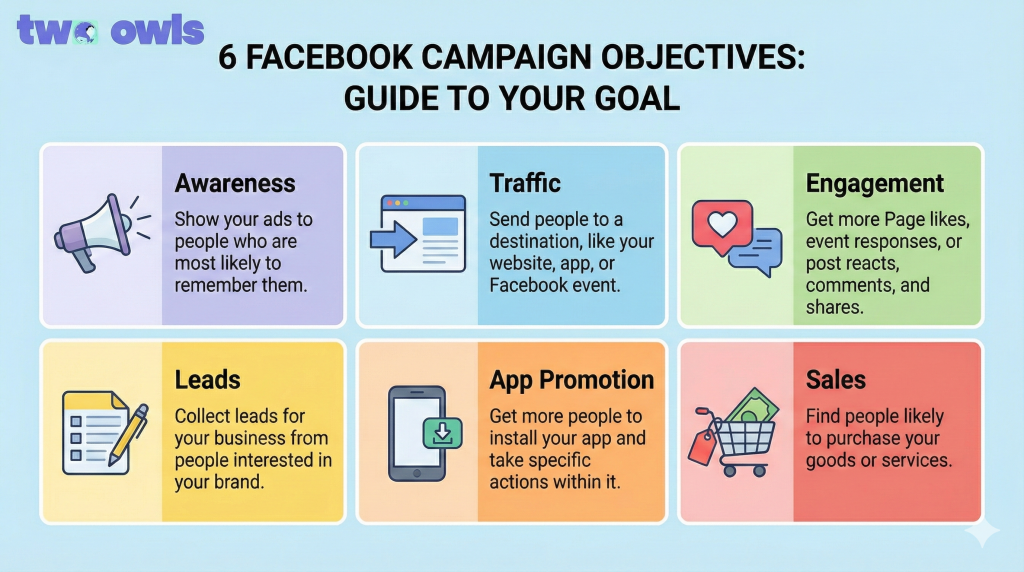
The best objective for your campaign will depend on your specific business goals. For example, if you're a new business, you might want to focus on awareness or engagement objectives. If you're an e-commerce business, you might want to focus on traffic or sales objectives.
Once you've chosen an objective, you can set up your campaign and start running ads. Meta will use your objective to optimize your campaign and deliver your ads to the people who are most likely to be interested in what you have to offer.
Campaign objectives vs conversion location & performance goals
Conversion location is the place where you want people to take a conversion action. This can be on your website, app, or even offline.
Meanwhile, performance goals are the specific metrics that you want to improve with your ad campaign. This could be anything from increasing website traffic to reducing customer acquisition costs.
It is important to have a clear understanding of the difference between campaign objectives, conversion location, and performance goals in order to create effective ad campaigns.
Here is an example of how these concepts work together:
- Campaign objective: Increase sales of your products on your website.
- Conversion location: Your website
- Performance goal: Increase the number of purchase conversions by 10% in the next month.
In this example, the campaign objective is to increase sales of products on the website. The conversion location is the website because that is where the advertiser wants people to take the desired action (making a purchase). The performance goal is to increase the number of purchase conversions by 10% in the next month. This is a specific, measurable, achievable, relevant, and time-bound goal.
By having a clear understanding of the difference between campaign objectives, conversion location, and performance goals, advertisers can create more effective ad campaigns and achieve their desired results.
6 Facebook campaign objectives
As mentioned before, there are 6 options for you to choose regarding Facebook Ad objectives:
Objective 1: Awareness
The Awareness objective in Facebook campaign objectives focuses on maximizing exposure and recognition for your brand. It's designed to reach a broad audience and leave a lasting impression, making it ideal for businesses aiming to enhance brand recall and visibility.
Conversion locations: None
Performance goals: include Maximize Reach, Boost Ad Recall, Maximize Impressions, ThruPlay Views, and Continuous 2-Second Video Views. Each aims at getting your ad seen by as many people as possible.
When and Why to use:
Choose the Awareness objective when your primary goal is to build brand awareness. It’s suitable for businesses with larger budgets, well-established brands, or those targeting a wide audience. This objective is especially useful when you want potential customers to remember your brand rather than taking immediate action.
Examples:
- New product launch: Use Awareness when introducing a new product to ensure it reaches a broad audience, creating initial brand recognition.
- Brand reinforcement: For well-known brands, use Maximize Impressions to consistently reinforce brand presence in the market.
- Event promotion: If you're organizing an event and want to maximize attendance, Awareness can help get the word out to a wide audience.
Objective 2: Traffic
The Traffic objective in Facebook campaign objectives revolves around driving users to a designated location, typically a website or a specific landing page. It's aimed at increasing the number of visits, clicks, and interactions with your chosen destination.
Conversion locations:
- Website: Get people to visit your website.
- App: Get people to download or open your app.
- Messaging Apps: Get people to send you messages on Messenger, WhatsApp, or Instagram.
- Calls: Inspire people to make a call to your business.
Performance goals include Clicks (Link Click-Throughs), Landing Page Views, and Impressions. These goals are geared towards measuring and optimizing user engagement and interaction.
When and Why to use:
Choose the Traffic objective when your primary goal is to generate visits to a website or a specific landing page. This is beneficial for businesses looking to increase online traffic, promote a product or service, or drive engagement.
Examples:
- E-commerce sales: If you're running an online store and want to boost sales, use the Traffic objective to drive potential customers directly to your product pages.
- Event registrations: When promoting an event and aiming for maximum attendance, use Traffic to direct users to the event registration page.
- Blog or content promotion: For businesses focusing on content marketing, Traffic is valuable for driving users to read articles, blog posts, or other relevant content.
Objective 3: Engagement
The Engagement objective within Facebook ads is centered around fostering interaction and participation. It aims to encourage users to engage with your content, such as liking, commenting, sharing, or reacting.
Conversion Locations:
- Ad Engagement (Video Views, Post Interaction, Event Responses): Encourage people to watch a video or engage with your post or event.
- Facebook Page: Drive engagement on your Facebook Page.
- Messaging Apps (Click to Message, Sponsored Message): Foster engagement on Messenger, WhatsApp, or Instagram.
- Website: Encourage engagement with your website.
- App: Drive engagement with your app.
Performance goals include Post Engagement, Page Likes, Comments, Shares, and overall interactions that signify a deeper engagement level.
When and Why to use:
Choose the Engagement objective when your primary goal is to create a community around your brand, encourage discussions, or promote content that benefits from active user participation. This is particularly valuable for businesses aiming to build a strong social media presence.
Examples:
- Brand awareness campaigns: Use Engagement for campaigns focused on creating brand awareness, where the goal is to foster conversations and interactions around your brand.
- Product launch Teasers: Before a product launch, use Engagement to tease the audience with sneak peeks, encouraging likes, shares, and comments to build anticipation.
- Interactive content: If your content strategy involves quizzes, polls, or other interactive elements, Engagement is the ideal objective to drive participation.
Objective 4: Leads
The Leads objective is used to generate leads for your business. This can involve getting people to sign up for your newsletter, download a white paper, or request a consultation.
Conversion Locations:
- Prompt Forms: Acquire leads by prompting individuals to complete a form.
- Prompt Forms and Messenger: Secure leads by either prompting them to fill out a form or redirecting them to Messenger.
- Instagram: Garner leads through chats on Instagram.
- Website: Gather leads through interactions on your website.
- Messenger: Attain leads by initiating chats in Messenger.
- Calls: Obtain leads by encouraging individuals to call your business.
- App: Collect leads through your application.
Performance goals include leads, conversion leads, conversions, landing page views, link clicks, daily unique reach, impressions, calls, and app events.
When and Why to use:
The Facebook Leads Ad is suitable when the primary goal is to collect user information, such as email addresses or other contact details. Use this objective when building a customer database or running promotions that require user sign-ups.
Examples:
- Newsletter Sign-up: If a merchant wants to expand their email subscriber list, they can use the Leads objective to encourage users to sign up for newsletters through a lead generation form.
- Event registration: For businesses organizing events, using the Leads objective can help gather registrations through a lead form, ensuring a direct channel for communication.
- Product trials: If a company offers free trials of their product or service, the Leads objective can drive users to sign up for a trial, providing valuable leads for potential future customers.
Objective 5: Sales
The Sales objective is a strategic choice within Meta campaign objectives for merchants aiming to directly boost product or service sales. It is designed to optimize ad delivery to people who are more likely to make a purchase, making it a powerful tool for businesses seeking tangible and immediate revenue generation.
Conversion Locations:
- Website/App: Enhance sales and conversions on your website or app.
- Messaging apps: Encourage interaction with your brand on Messenger, WhatsApp, or Instagram.
- Calls: Stimulate sales and conversions through phone calls.
Performance goals include conversions, value of conversions, landing page views, link clicks, daily unique reach, impressions, calls and app events.
When and Why to use:
Choose the Sales objective when the primary goal is to drive immediate and direct transactions. It is tailored for businesses prioritizing revenue generation and ideal for promoting new products or special offers to a wide audience with a high potential for conversion.
Example:
- E-commerce launch: An online clothing store using the Sales objective to promote and sell a new line of products, optimizing for purchase conversions.
- Flash sale: A tech retailer leveraging the Sales objective to swiftly sell excess inventory during a limited-time flash sale, optimizing for quick purchases.
Objective 6: App promotion
The App Promotion objective is designed to drive installations and engagement with a mobile application. This objective is particularly beneficial for merchants who want to increase their app user base, encourage specific actions within the app, or promote new features to existing users.
Conversion Location: your app
Performance goals include app installs, value of conversions, app events and link clicks.
When and Why to use:
Use the App Promotion objective when aiming to boost app installations, increase user engagement, or promote specific features. Merchants with a mobile app can leverage this objective to maximize app visibility and drive valuable actions.
Example:
- E-commerce App: A retail business launching a new mobile app might use App Promotion to encourage installations and prompt users to make their first purchase within the app.
- Feature Highlight: An app introducing a new feature, such as exclusive discounts, can use this objective to drive user interactions with the feature.
How to choose Facebook campaign objectives for a merchant?
Choosing the perfect campaign objective is akin to picking the right tool for the job in the digital marketing realm. While the ideal choice varies based on individual goals, one standout and versatile option for many merchants is the "Conversions" objective.
Why opt for conversions as the primary objective?
- Directly tied to revenue: The Conversions objective aligns seamlessly with revenue generation. It's tailored for merchants looking to drive actions that lead to sales, making it a potent choice for businesses aiming to boost their bottom line.
- Measurable ROI: Conversions are not just about engagement; they are about measurable results. Merchants can precisely track the return on investment (ROI) of their ad spend, providing a clear picture of campaign effectiveness.
- Flexibility: The Conversions objective offers flexibility in terms of the desired action, whether it's making a purchase, signing up for a newsletter, or completing any other valuable action. This adaptability makes it suitable for a wide array of businesses.
- Audience growth: Beyond immediate sales, the Conversions objective aids in audience growth. It helps expand customer databases, creating opportunities for ongoing engagement and future sales.
- Optimization for action: With the Conversions objective, the focus is on actions that matter. Whether it's driving app installs, form submissions, or product purchases, merchants can optimize their campaigns for the specific actions that contribute to business objectives base on Facebook pixel.
Example:
Consider an e-commerce merchant launching a new product. By selecting the Conversions objective and optimizing for online purchases, they not only drive sales but also gather valuable data on customer preferences, enabling future targeted marketing efforts. It's like hitting two birds with one well-targeted ad – revenue today and insights for tomorrow.
FAQ
What is the best KPI in Facebook ads?
The best KPI in Facebook ads depends on your campaign objective. For awareness, focus on Reach and Impressions; for conversions, prioritize Conversion Rate and Cost per Conversion; for consideration, look at Click-Through Rate (CTR) and Engagement Metrics.
Learn More: Facebook Ad Metrics Mastery 2026: Unlocking The Secrets To Optimize Ads
How many objectives should a marketing campaign have?
A marketing campaign typically has multiple objectives, each serving a specific purpose in the overall strategy. Common ad objectives include Awareness, Traffic, Engagement, Leads, and Sales. The number and choice of objectives depend on the campaign's goals and the customer journey you want to facilitate.
Introducing Real-time TikTok event testing - Omega TikTok Pixels
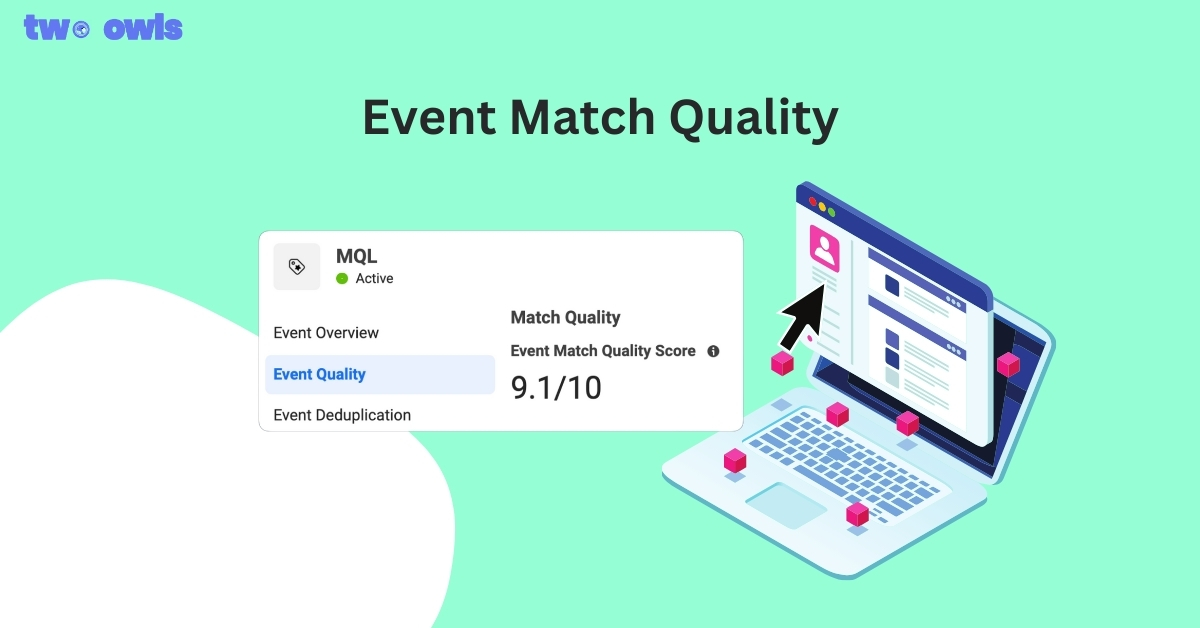
Event Match Quality: Definition, Benchmarks & How to Improve It
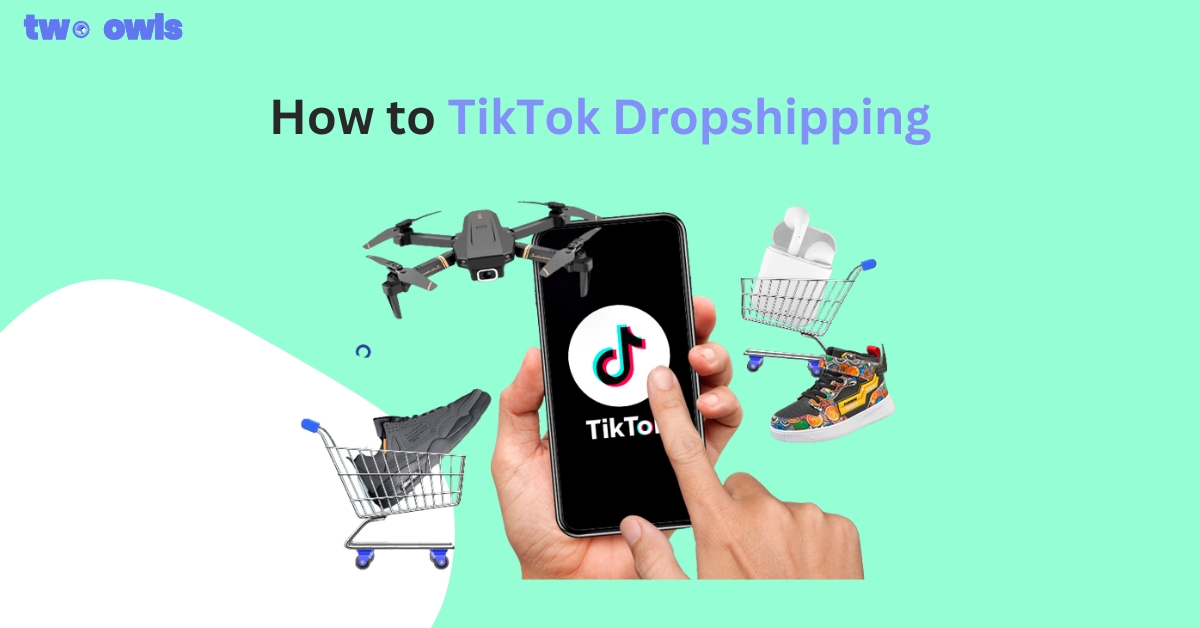
TikTok Dropshipping: How to Build a Profitable Store in 2026
